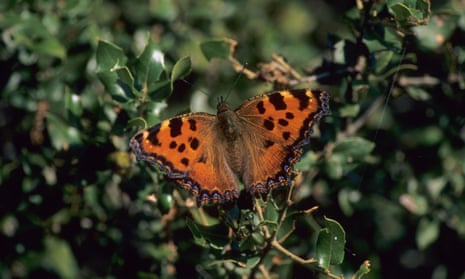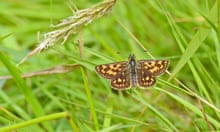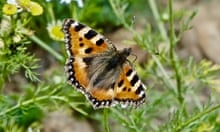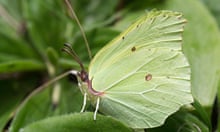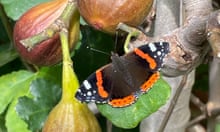An elusive butterfly that has been officially extinct in Britain for more than half a century has been discovered breeding on the rewilded estate of Knepp in West Sussex.
The large tortoiseshell mysteriously vanished more than 50 years ago but this week male and female butterflies – much larger than the small tortoiseshell and without its white patterning – have been spotted at Knepp for the first time.
Neil Hulme and Matthew Oates, the lepidopterists who made the discovery, have also found signs of its caterpillars consuming leaves of wych elm in the rewilded farmland earlier this spring.
“This butterfly is still officially extinct but the evidence suggests it is making a comeback,” said Oates. “This is a scrubland species and historically and culturally we’ve hated the word ‘scrub’ and done all we can to eliminate it in the countryside. There is ideal scrub for it at Knepp.”
Since 2019, small numbers of the butterfly have been found breeding at Portland on the Dorset coast, with adults identified alongside the egg cases and webbing produced by large tortoiseshell caterpillars. Another colony has been discovered in an East Sussex valley.
Large tortoiseshell caterpillars feed on a variety of trees including elm, aspen, sallow, and fruit trees, and it is not known precisely why the species became extinct in the 20th century. Theories include populations being attacked by parasites, Dutch elm disease and the loss of orchards and scrub such as sallow, which were removed from woodlands when conifers were planted. The butterfly feeds on sallow flowers in the spring.
The butterfly was last seen widely in the late 1940s. Since the 1950s there have been only occasional sightings of individual butterflies, often close to the coast, suggesting that a few were arriving from overseas without breeding.
According to Oates, numbers of the large tortoiseshell are rising on the continent again – possibly because of climate change – and increasing numbers are now crossing the Channel to arrive on the south coast.
But the picture is confused because some maverick butterfly breeders have also been secretly releasing the species.
Oates said there were too many sightings close to the south coast for all to be the work of breeders, with the species being difficult to rear in captivity as well. “I don’t believe butterfly breeders would all travel to the south coast to let them go. They are coming in as well,” he said.
The adult butterflies emerge in July and soon disappear to hibernate, not mating until the following spring.
“You’ve got to have lots of them coming over for them to find a mate and they must have a highly sophisticated mate-finding strategy,” said Oates. “How do they pair up if they are living at this low density? There’s a lot we still need to learn about this butterfly.”
It has been a bountiful season for wildlife at Knepp, with record numbers of nightingales – 40 singing males – recorded on the estate this summer alongside a record nine nests of storks, which have been reintroduced and have already attracted other wild storks from the continent.
Isabella Tree, who began rewilding Knepp with her husband, Charlie Burrell, 20 years ago, said: “We always think we’ve got to intervene and bring things back but again and again we see that it’s just about habitat and providing the space for nature and many species can come back on their own.”
